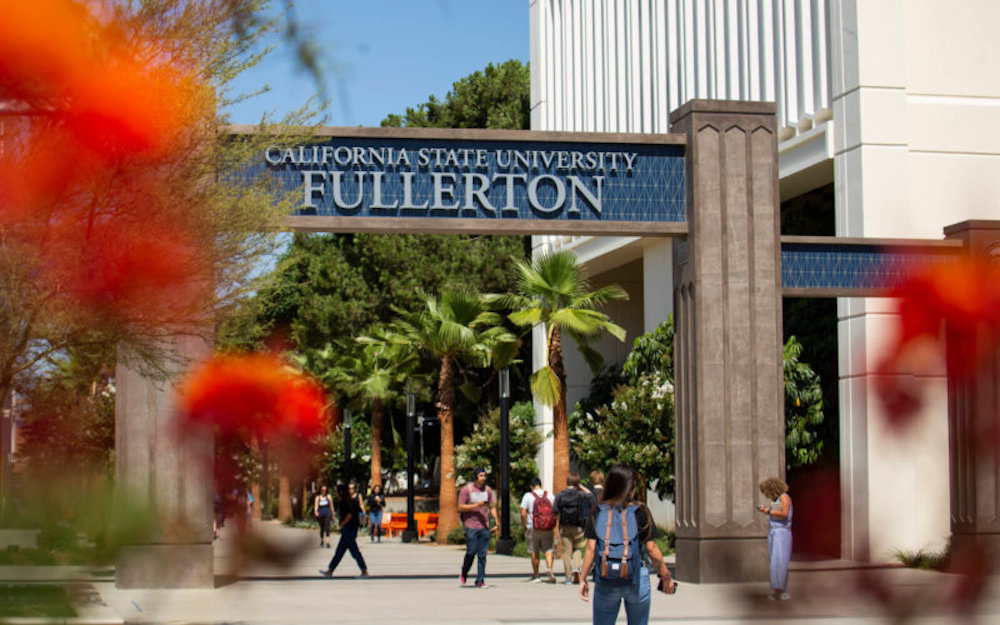
- Details
- By Jenna Kunze
A public university in California has begun the process of returning an unconfirmed number — thought to be around 213—of Native American human remains and burial objects to their respective tribal nations.
The repatriation activity by California State University Fullerton promises the return of Native ancestors and artifacts found in some 3,500 boxes that were not previously inventoried. It comes about a quarter-century after the southern California school first repatriated some of the Native American human remains it held in inventory.
In September 2022, Cal State Fullerton created a new staff position to support the process of inventorying and repatriating previously unreported collections of Native American skeletal remains and their burial objects held in archival collections on the university’s campus.
The position was created for Cal State Fullerton to comply with a 32-year old federal law, the Native American Graves Protection and Repatriation Act (NAGPRA). Signed into law in 1990, NAGPRA requires museums, universities, and federal agencies to inventory the Native American human remains and sacred objects in their collections, report that inventory to the federal government, and consult with affected tribal nations for repatriation.
Although Cal State Fullerton submitted an inventory to the federal government in 1996, only a small fraction of the school’s total holdings were included. The university originally reported about two dozen ancestors, returning 16 of them to a Native Hawaiian Organization in Maui that same year.
In the almost three decades since, Cal State Fullerton hasn’t completed any additional repatriations.
Now, increasing public and media attention on the repatriation of Native American ancestors and artifacts, paired with an impending state audit and a state law that bolsters and reinforces the law — called CalNAGPRA — Cal State Fullerton is the latest in a series of institutions in the state and across the country to prioritize their repatriation efforts. CalNAGPRA was last amended in 2020 to compel institutions to prioritize tribal knowledge in the repatriation process, and ensure an open process for the participation of tribal governments.
Additionally, California’s first Native American Assemblymember, James Ramos (Serrano/Cahuilla tribes), asked the state legislature in 2022 to commission an independent state audit of the California State University system— comprised of 23 campuses and eight off-campus centers— for its compliance with NAGPRA and CalNAGPRA.
“It's an ongoing audit right now, and it’s going to have its initial findings come out in August,” Ramos told Native News Online. “Which then allows us to identify the potential of how many remains are in the archives of the Cal State University system, and areas that need to be addressed, areas that aren't working so well, and maybe some areas that are. It will give us a picture of what's going on.”
Vice Provost Estela Zarate, who is overseeing the repatriation work on the school’s campus, told Native News Online that the university is proud of the work it's done in the past year, and awaiting the audit to use as a guidepost.
“We’re expecting that audit report will also have some recommendations, so we’re looking forward to it,” she said.
A similar audit of the University of California system, published in June 2020, identified a sample of at least 500,000 Native American human remains. The audit included recommendations for the state’s universities, its legislature, and the California Native American Heritage Commission.
In the last fiscal year, Cal State Fullerton has spent $500,000 to back its repatriation efforts, according to the university’s CalNAGPRA Repatriation Coordinator Megan Lonski. That money has gone towards hiring expert staff to review each box in the university’s collection, and to initiate tribal consultations with nearly 50 affected state and federally recognized tribes in California.
Through the process of reviewing the boxes, which were stored in repositories in the university’s anthropology department and another building on campus, Lonski said staff found “additional ancestors and funerary objects.” University staff is still finalizing the minimum number of individuals discovered in the boxes, she said, but the university plans to update its existing inventory in the federal database.
“Those boxes represent about 274 sites and donations from around the area, so it was never fully inventoried,” Lonksi told Native News Online. “Quite frankly, I do not know why, when the federal inventories were submitted in 1996, only a portion of the remains were included. That was so far before my time, and there's not a lot of institutional memory.”
According to the university website, the human remains and belongings “are primarily from southern California and were acquired through intentional excavation, unintentional discovery, or by donation.”
The vast majority of ancestors discovered have information about where they were dug out of the ground, Lonski said, and can thus be geographically affiliated to a present-day tribe.
Currently, Lonski is actively consulting with affected tribes for each ancestor, including the newly identified ones, and all cultural items. Cal State Fullerton is drafting its federal notice of inventory completion, a required document that summarizes the contents of a completed inventory of human remains and associated funerary objects and enables relevant tribal nations to begin the process of claiming them.
Additionally, Lonski is shepherding through a repatriation process that had previously fallen through the cracks: In 2014, Cal State Fullerton published a notice of inventory completion for one female ancestor and three bits of pottery excavated from a burial cave in 1966 in Inyo County, Calif., that were later donated to the university. But, for unknown reasons, the ancestor and her belongings were never physically returned back to the affiliated tribe, the Lone Pine Paiute-Shoshone Tribe. Lonski is currently in the process of organizing the transfer of the woman’s remains and pottery to the Tribe, whose traditional territory encompasses the burial site where the ancestor was dug up by amateur archaeologists, according to the federal notice.
Assemblyman Ramos said that he’s going to continue to push legislation to keep institutions’ “feet to the fire” and ensure each ancestor held by an institution in California is returned home for a proper reburial, without taking another three decades.
“If we step back and don't keep the pressure on, the last twenty-something years show that it will be slow coming to fruition.”
More Stories Like This
50 Years of Self-Determination: How a Landmark Act Empowered Tribal Sovereignty and Transformed Federal-Tribal Relations“Our Sovereignty Is Not Optional”: Tulalip Responds to ICE Actions
Denied Trip to Alcatraz, Leonard Peltier Tells Sunrise Gathering: “My Heart Is Full”
‘Meet your prayer halfway’ | Women-Led Bison Harvests Bring Tribal Food Sovereignty
San Manuel Tribe Reclaims Ancestral Name, Faces Vandalism on Holiday
Help us defend tribal sovereignty.
At Native News Online, our mission is rooted in telling the stories that strengthen sovereignty and uplift Indigenous voices — not just at year’s end, but every single day.
Because of your generosity last year, we were able to keep our reporters on the ground in tribal communities, at national gatherings and in the halls of Congress — covering the issues that matter most to Indian Country: sovereignty, culture, education, health and economic opportunity.
That support sustained us through a tough year in 2025. Now, as we look to the year ahead, we need your help right now to ensure warrior journalism remains strong — reporting that defends tribal sovereignty, amplifies Native truth, and holds power accountable.
 The stakes couldn't be higher. Your support keeps Native voices heard, Native stories told and Native sovereignty defended.
The stakes couldn't be higher. Your support keeps Native voices heard, Native stories told and Native sovereignty defended.
Stand with Warrior Journalism today.
Levi Rickert (Potawatomi), Editor & Publisher


